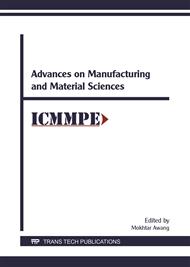[1]
S. Abrate; Composites Engineering Hand book, Marcel Dekker, (1997).
Google Scholar
[2]
Reddy, J., and Reddy, J. (2004). Mechanics of laminated composite plates and shells. Boca Raton: CRC Press.
Google Scholar
[3]
HRN EN ISO 527-4: 2008 Plastics: Determination of tensile properties, Part 4: Test conditions for isotropic and orthotropic fibre reinforced plastic composites).
DOI: 10.3403/30409901
Google Scholar
[4]
Gay D, Hoa SV and Tsai SW, Composite materials. Design and applications, Boca Raton, FL: CRC Press, (2003).
Google Scholar
[5]
Tomasz Brynk, , Rafal M. Molak, Miroslawa Janiszewska, Zbigniew Pakiela, Digital Image Correlation measurements as a tool of composites deformation description, Computational Materials Science Volume 64, November 2012, Pages 157–161.
DOI: 10.1016/j.commatsci.2012.04.034
Google Scholar
[6]
Jerabek, Z. Major and R. W. Lang, Strain determination of polymeric materials using digital image correlation, Polym. Test., 29 (2010) 407–417.
DOI: 10.1016/j.polymertesting.2010.01.005
Google Scholar
[7]
Drugan, W. J., & Willis, J. R. (1996). A micromechanics-based nonlocal constitutive equation and estimates of representative volume element size for elastic composites. Journal of the Mechanics and Physics of Solids, 44(4), 497–524.
DOI: 10.1016/0022-5096(96)00007-5
Google Scholar
[8]
Gusev, A., 1997, Representative volume element size for elastic composites: A numerical study. Journal of the Mechanics and Physics of Solids 45, 1449–1459.
DOI: 10.1016/s0022-5096(97)00016-1
Google Scholar
[9]
Terada K., Hori M., Kyoya T., Kikuchi N., 2000, Simulation of the multi-scale convergence in computational homogenization approaches. Int. J. Solids Struct. 37, 2285-2311.
DOI: 10.1016/s0020-7683(98)00341-2
Google Scholar
[10]
Matthew F L, Davies G A O, Hitchings D, Soutis C 2000 Finite element modeling of composite materials and structures (CRC Press: Woodhead Publishing Limited.
Google Scholar
[11]
M. Moravcík, P. Kotula, and F. Bahleda, Experimental and FEM analysis of hybrid composite structures with GFRP elements, Procedia Engineering, vol. 40, p.268–273, (2012).
DOI: 10.1016/j.proeng.2012.07.092
Google Scholar
[12]
P. F. Liu, J. Y. Zheng, Recent developments on damage modeling and finite element analysis for composite laminates: A review, Material and Design, Vol. 31, pp.3825-3834, (2010).
DOI: 10.1016/j.matdes.2010.03.031
Google Scholar
[13]
Ansys Manual Documentation 12. 1 Mechanical APDL, (2010).
Google Scholar
[14]
P.W. Manders, M.G. Bader, The strength of hybrid glass/carbon fibre composites. Part 1 Failure strain enhancement and failure mode, Journal of Materials Science, Vol. 16, pp.2233-2245, (1981).
DOI: 10.1007/bf00542386
Google Scholar
[15]
Swolfs, Y., Gorbatikh, L., Verpoest, I.: Fibre hybridisation in polymer composites: A review, Composites Part A: Applied Science and Manufacturing, 67(2014), 181-200.
DOI: 10.1016/j.compositesa.2014.08.027
Google Scholar
[16]
C. L. Tan, A. I. Azmi, and N. Mohamad, Performance Evaluations of Carbon/Glass Hybrid Polymer Composites, Adv. Mater. Res, Vol. 980, p.8–12, Jun. (2014).
DOI: 10.4028/www.scientific.net/amr.980.8
Google Scholar
[17]
Y. Swolfs, L. Gorbatikh, and I. Verpoest, Fiber Hybridisation In Polymer Composites: A Review, Compos. Part A, vol. 67, p.181–200, (2014).
DOI: 10.1016/j.compositesa.2014.08.027
Google Scholar
[18]
M. N. Gururaja and A.N. Hari Rao, A review on recent applications and future prospectus of hybrid composites, International Journal of Soft Computing and Engineering (IJSCE), Vol. 1 (6), p.352 – 355, (2012).
Google Scholar
[19]
Jin Zhang, Khunlavit Chaisombat, Shuai He and Chun H. Wang; Hybrid composite laminates reinforced with glass/carbon woven fabrics for light weight load bearing structures, Mater Design, Vol. 36, pp.75-80, (2012).
DOI: 10.1016/j.matdes.2011.11.006
Google Scholar


